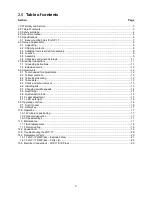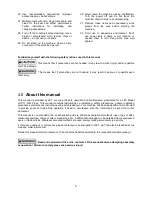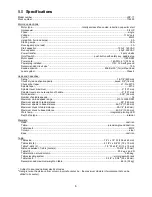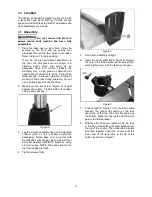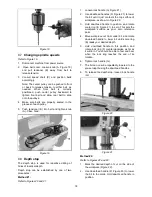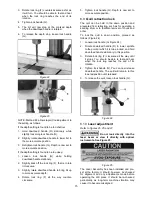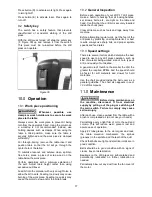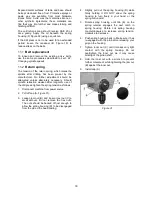
17
Press button (D) to activate work light. Press again
to turn light off.
Press button (E) to activate laser. Press again to
turn off.
9.2
Safety key
The switch has a safety feature that prevents
unauthorized or accidental starting of the drill
press.
With the drill press turned off, slide the safety key
(F, Figure 30) up and remove it from the switch.
This piece must be re-inserted before the drill
press can operate.
Figure 30
10.0
Operation
10.1
Work piece positioning
Whenever possible, use
clamps or work hold-downs to secure the work
piece to the table.
Always secure the work piece to prevent it being
torn from the operator’s hand. Using the column as
a workstop is not recommended; instead, use
holding devices such as clamps. When using the
table in tilted position, make sure the table is
securely tightened and the work piece is clamped
sufficiently.
For through-boring, remove the table insert and
position table so that the bit will go through the
center hole of the table.
To minimize tear-out, and achieve clean, splinter-
free holes, place a piece of scrap wood on the
table below the work piece.
Perform operations with a minimum extension of
the quill. Adjust table height rather than using
excessive quill travel.
Feed bit into the material with only enough force to
allow the bit to work. Feeding too slowly may cause
burning of the work piece. Feeding too quickly may
cause the motor to slow and/or the bit to break.
10.2
General Inspection
Before each operation of your JDP-17 drill press,
make a habit of checking that all locking handles,
set screws, bolts, etc., are tight on the table and
head. Confirm that the drill bit is securely inserted
inside the chuck jaws.
Clear all items, such as tools and rags, away from
machine.
Before attempting regular work, get the feel of the
drill press by practicing on scrap material. For best
results, always use sharp bits, and proper spindle
speeds and feed rates.
10.3
Speed settings
There are several factors which determine the best
speed to use in any drill press operation, such as
kind of material being worked, size of hole, type of
drill, and quality of cut desired.
A general rule of thumb is, the smaller the drill, the
greater the required RPMs. And the speed should
be faster for soft materials and slower for hard
materials.
Use the chart provided inside the belt cover as a
general guideline. The chart also appears in
sect.
12.0
of this manual.
11.0
Maintenance
Before doing maintenance on
the machine, disconnect it from electrical
supply by pulling out the plug or switching off
the main switch. Failure to comply may cause
serious injury.
After each use, clean sawdust from the table with a
brush or compressed air (do not use your hands).
Periodically apply a light film of oil to the quill and
column. This will reduce wear, prevent rust and
assure ease of operation.
Apply #2 tube grease to the worm gear and rack,
the table elevation mechanism, the splines
(grooves) in the spindle, and the teeth of the quill.
Check that bolts are tight and electrical cords are in
good condition.
Belts should be in good condition with no signs of
cracks, frays or deterioration.
Bearings on the drill press are self-contained and
permanently lubricated; no further lubrication is
needed.
Periodically blow out any dust from the fan cover of
the motor.
Summary of Contents for JDP-17
Page 19: ...19 12 0 Speed chart Table 2 JDP 17 recommended drill speeds chart also located in machine hood...
Page 21: ...21 14 1 1 JDP 17 Drill Press Exploded View...
Page 25: ...25 15 0 Electrical Connections JDP 17 Drill Press 1 Phase 115V only...
Page 26: ...26 This page intentionally left blank...
Page 27: ...27 This page intentionally left blank...
Page 28: ...28 427 New Sanford Road LaVergne Tennessee 37086 Phone 800 274 6848 www jettools com...

